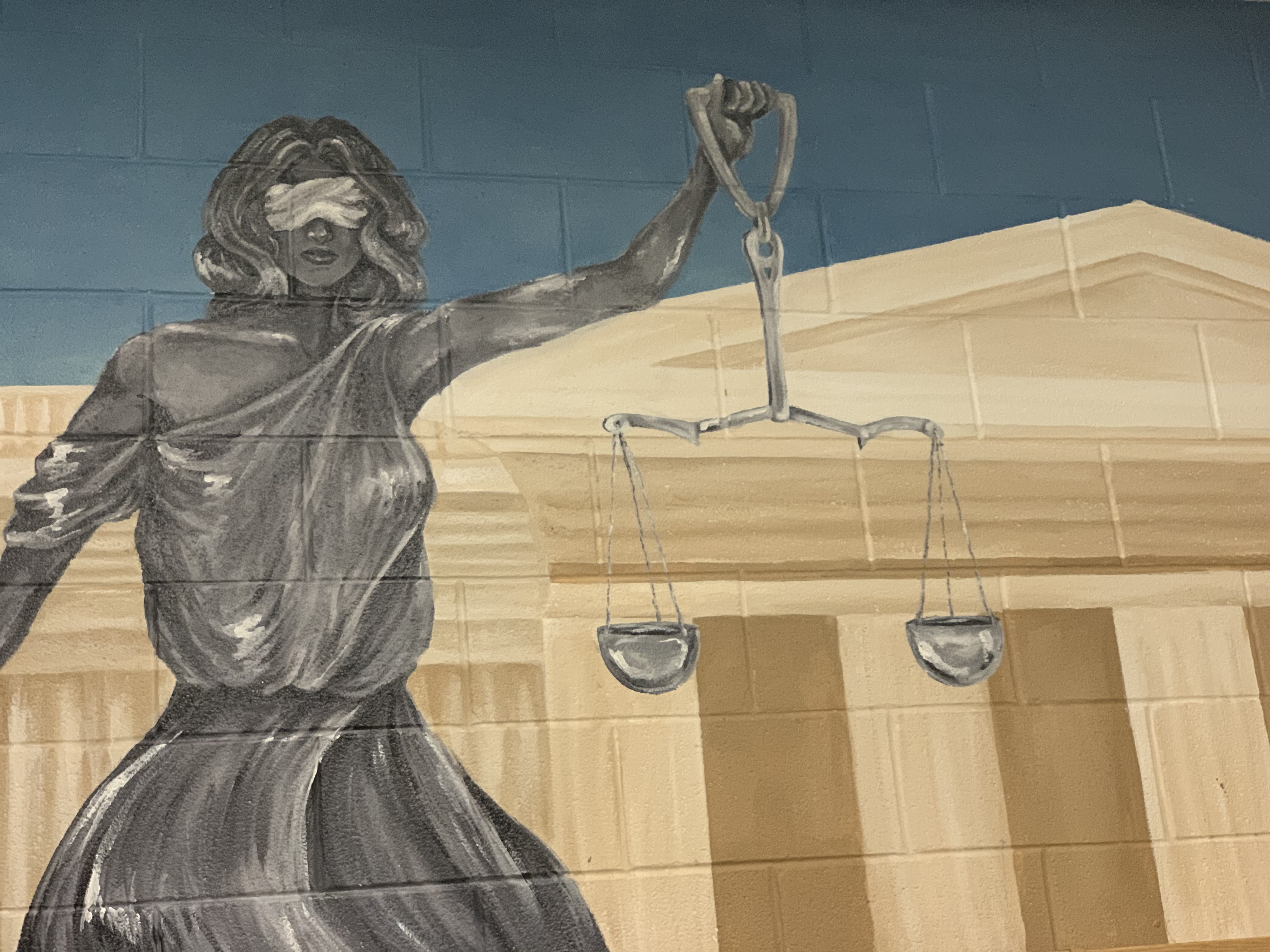Veda Ouwehand, a senior, painted this mural in the Leesville media center. The mural is a representation of how the justice system is blind, and sees everyone as equal. (Photo courtesy of Samiyah Hargrove).
Background
The US Supreme Court supsdened capital punishment in 1972, then reinstated it in 1976. Since the legalization of the death penalty, courts have executed 1,499 people. The death penalty is legal in all states, but only 29 US states choose to implent it including Florida, Texas, Alabama, Mississippi, and many more. Execution was mainly sentenced to black men who were accused of raping white women, but now judges can only give the death penalty if the crime involved a murder.
Wrongful Convictions
There is no guarantee that every person given the death penalty deserved it. In fact, “more than 165 people who have been wrongly convicted…have been exonerated,” according to the Death Penalty Organization Center.
David Keaton was the first death row exoneree. He was one of five black men who the state of Florida wrongly sentenced to death for the murder and robbery of an off duty sheriff in 1970. These men were famously known as the Quincy Five. The only evidence that connected Keaton and the four other men to the crime was the victim who referred to the men as “perpetrators,” said Gerald Ensle, a senior democrat writer. This alone was not enough to charge the men of this crime, but in 1971 they were all convicted. Months after the Quincy Five’s arrest, a man charged for a separate murder named the three Jackson men who were responsible for the 1970 robbery. In 1972, the court dropped all charges against the Keaton and the four other men.
Racial Biases
Racial biases are something that have been a problem. We can’t change the way people think, but in the courtroom especially, everyone should see each other as equals.
In North Carolina between 1993 and 1997, “death sentences increased three and a half times when the victim was white rather than black,” according to America Civil Liberties Union. The Sixth Amendment grants you a public trial with a jury of your peers, but in cases where the defendant is black and the jury is mostly white, this does not apply. The Mississippi court tried Curtis Flowers six times for the same crime. In 2010 the Mississippi court charged Flowers for a 1996 quadruple murder and sentenced him to death. His jury included 11 white men and one black man. The state accused district attorney Doug Evans of discriminating against potential black jurors. In a span of 15 years,“Evans struck black potential jurors 4.4 times the rate he struck white potential jurors,” said Michelle Liu, a member of Reports for America.
Attorney Quality
Not every defendant can afford a high-quality attorney, which could result in them losing their case. Yes, you have the right to an attorney if you can not afford one, but there is no guarantee that the defendant’s attorney will be as qualified as the victim’s attorney.
Not all counties can afford to give a defendant a high-quality lawyer, in fact, “counties who are responsible for assigning and compensating lawyers… cannot afford the kind of representation a capital case requires,” according to the Death Penalty Information Center. Brian Douglas Horn was on trial in Louisiana for the first-degree murder of a 12-year-old boy. The court overturned Horn’s case when his lawyer, who the state gave to him, suggested the jury to find his defendant guilty of second-degree murder. Horn’s lawyer did not consult with him before telling the jury to find him guilty.
Costly
In North Carolina, the death penalty costs an approximant $2.16 million per execution. It would be more cost-efficient to give the defendant life without parole. The costs of the death penalty consists of legal costs, trail cost, and other expenses. Most people on death row can not afford an attorney. In fact, “in 2012, state governments spent $2.3 billion nationally on indigent defense,” according to the US Department of Justice. Capital cases have longer and more expensive trials than non-capital cases. “A death penalty case [cost] 70% more than the cost of a comparable non-death penalty case,” according to the Amnesty International Program. The average cost of a death is $1.26 million compared to the $740,000 it cost for a non-death penalty case.
Alternative Sentences
Most states that have the death penalty also have an option of life without parole. Although life without parole doesn’t ultimately kill the defendant, it still results in the criminals spending the rest of their lives behind bars. Life without parole has the same effect on the defendant that the death penalty does. Due to the controversy and the expenses that go with having the death penalty, life without parole should be the alternative for capital punishment.

Hi! My name is Mariah and I am a staff writer and social media editor for The Mycenaean. I am also a member of Black Student Union and Track and Field.

Leave a Reply